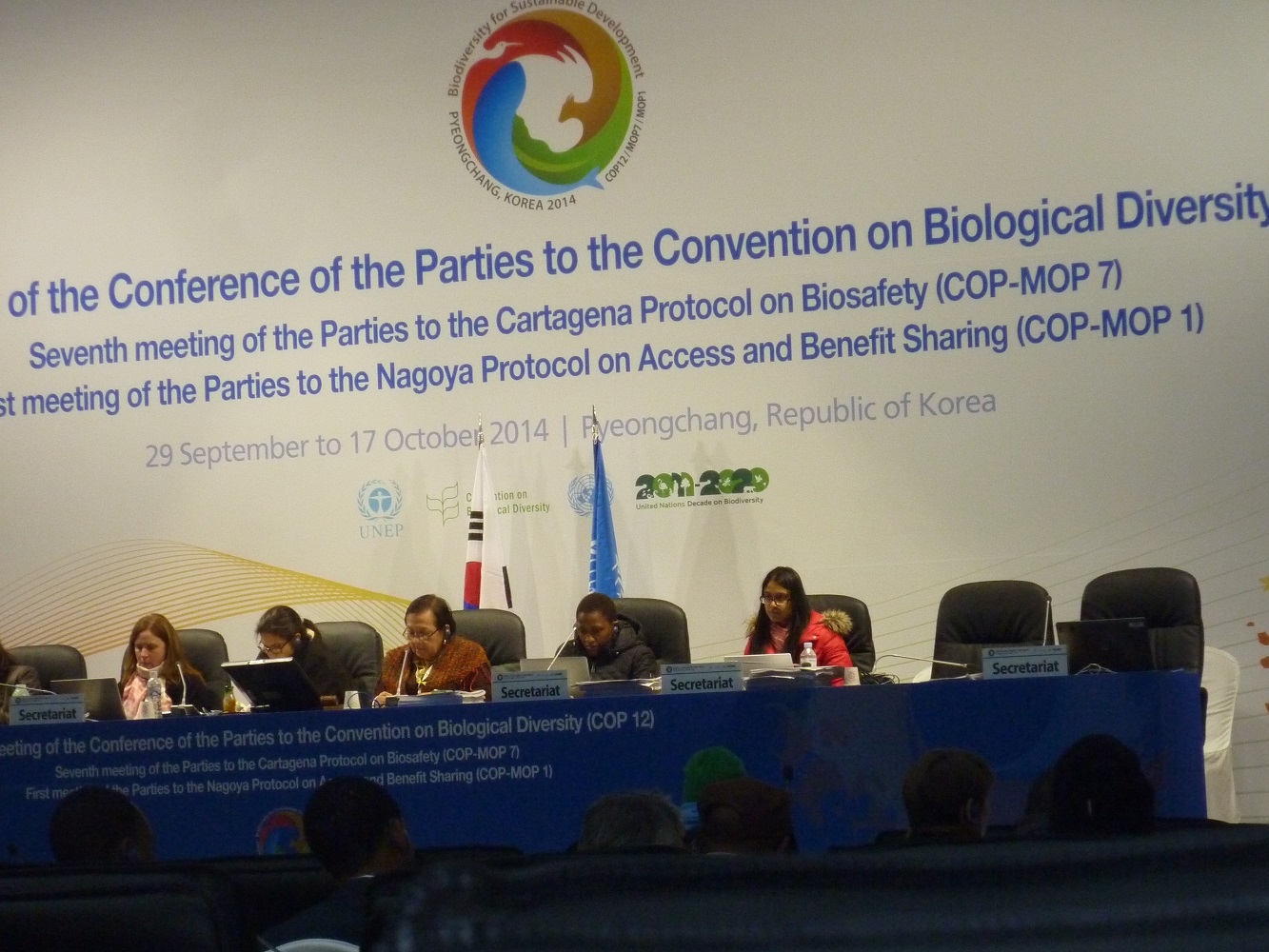Last week I was in Korea, where I attended the last two days of the twelfth meeting of the Conference of Parties to the Convention on Biological Diversity. This meeting is simple referred to as CBDCOP12. I was there together with the new INBAR Director of Communications and Outreach, Michael Devlin, and we had a busy few days.
CBDCOP12 was organised in a sky resort in Pyeongchang, some three hours drive from Incheon International Airport. It was cold in Pyeongchang, and the discussions took place in large tents. Picture delegates sitting at their desk with coats, scarves and even hats and gloves – that was CBDCOP12!
This is not the first time that I attend such a meeting. When I worked for IUCN, I participated in several “COPs”, and they have always seemed special events. Most of the time during the plenary meetings towards the end of the COP is spent on debating the details of text of various documents, and there is no longer room for presentation of new thoughts or discussions of substance. That happened in the preparatory meetings and earlier in the first week. Towards the end of the COP, there are only side events where substantive issues are presented and debated.
INBAR hosted one of the side events this year, and the main aim was to launch the nine finalists of the TVE Biomovies competition. Ethiopia is the Chair of the INBAR Council, and I was very happy that the Head of the Ethiopia Delegation to COP12, Dr. Gemedo Dalle Tussie, gave the opening remarks at our side event. The Biomovies competition asked young media people to propose scripts for short videos. The judging team chose the 9 most promising proposals, and the film-makers were given financial and technical assistance by TVE to produce their video. This year, we had three categories: a) bamboo and rattan, b) renewable energy and c) protecting the world’s environment. INBAR was the sponsor for the bamboo and rattan category, and therefore we hosted the launch of the final videos.
The winners were nine interesting films with different perspectives. The bamboo and rattan finalists are from Bolivia, Nepal and Zimbabwe. The Bolivian video describes a bamboo clump that is dreaming of flying. The pole is cut and the material used to make a kite. The film ends with the bamboo flying, and the message that you can do anything with bamboo! The Nepal entry describes a boy who is drawing a picture and who is slowly losing his pens, his drawing and even his clothes. The message is not to ignore the values of bamboo. The video from Zimbabwe is a series of short interviews with poor kids on the streets of Harare or Bulawayo who make a range of things from bamboo and rattan. The message is that bamboo is very versatile and its uses are unlimited. All nine films are now on-line and we are asking the public to watch and vote!
We also used the side event to talk about a project in India that INBAR was involved in from 2000 to 2003. We were very fortunate to get the perspective on Mr Hem Pande, the Additional Secretary of the Ministry of Environment, Forests and Climate Change in India, who joined us briefly at the event. The project aimed at helping poor farmers in an area that had been devastated during brick making, and the top soil had been stripped for several metres. INBAR and its local partner Utthan started a re-planting project with bamboo, which was very successful. We published a report “Greening Red Earth” and a few years after the project ended Utthan received the Alcan Sustainability Prize.
Earlier this year, I wondered what had happened, and asked one of my colleague to go back to the same place and have a look, take some photos and talk with local people. The result was not as imposing as we had hoped, as there is no large bamboo forest! But, the results are actually very impressive. Farmers have used bamboo as the keystone in an integrated agro-forestry and inter-cropping system, and as a result they are now doing well, gaining at some 10% of their income from bamboo. Bamboo provides all kinds of obvious services and it is a source of material for furniture making and construction. We started with a few hundred hectares in 2000 and now Utthan has covered 85,000 hectares. It is a real success story, which we will present in a new publication later this year.
Apart from hosting the side event, we also participated in the general discussion, and in the corridors I bumped into old and new acquaintances. Many former IUCN colleagues were at the meeting, and it was very nice to renew contacts with former staff and peers. I also met with representatives of the INBAR network, and especially the dinner with Vice Minister Adobo from the Philippines and his whole delegation was a very nice experience.
We also had meetings with representatives from Korea. Discussions with the Department of Forestry focused on the possibility of Korea becoming a member of INBAR. We talked with a delegation from Damyang Province, as this is where the World Bamboo Fair and the World Bamboo Congress will take place next year in September. INBAR still has to work out what it will do in Damyang, but it is clear that I will be back in Korea next September!





Dear Mr Lakshmana
Thank you for this message. Please send an email to my INBAR email account: hfriederich@inbar.int so that I can respond properly. Best regards. Hans Friederich.